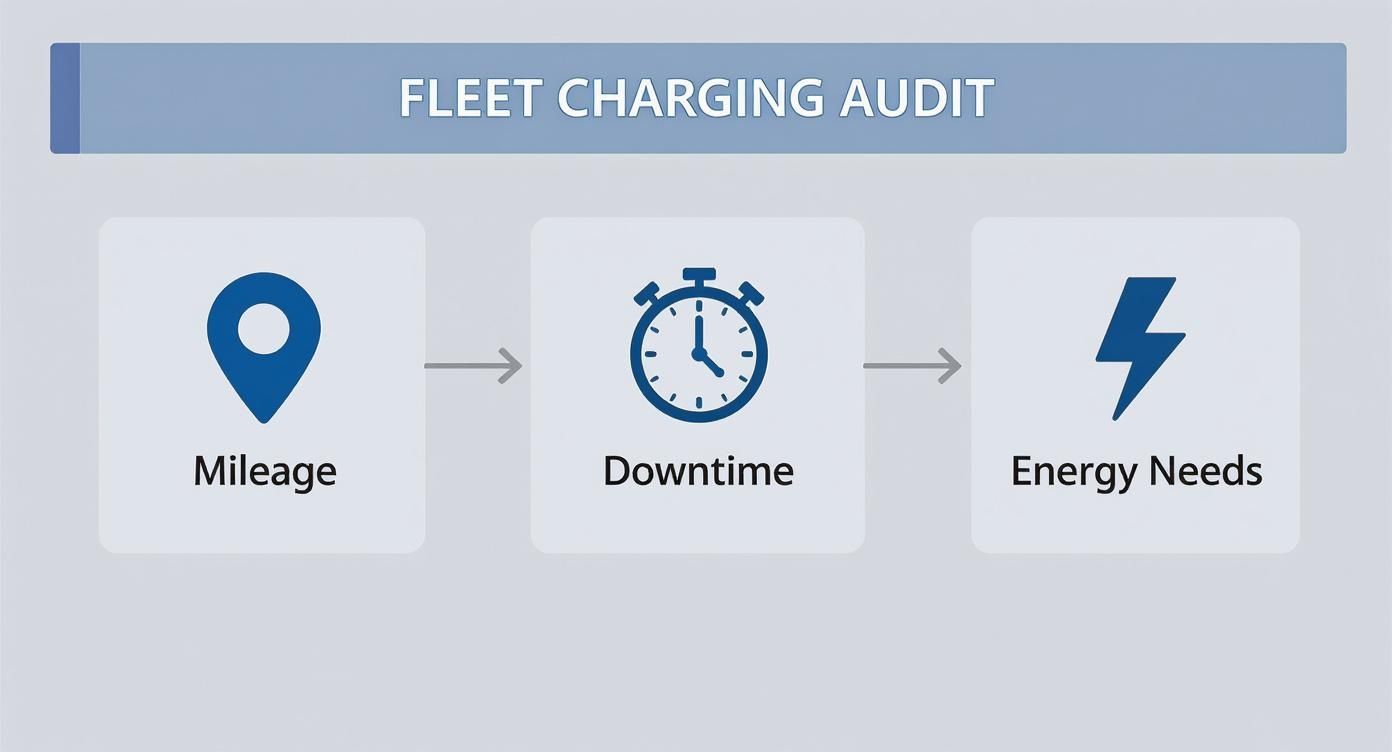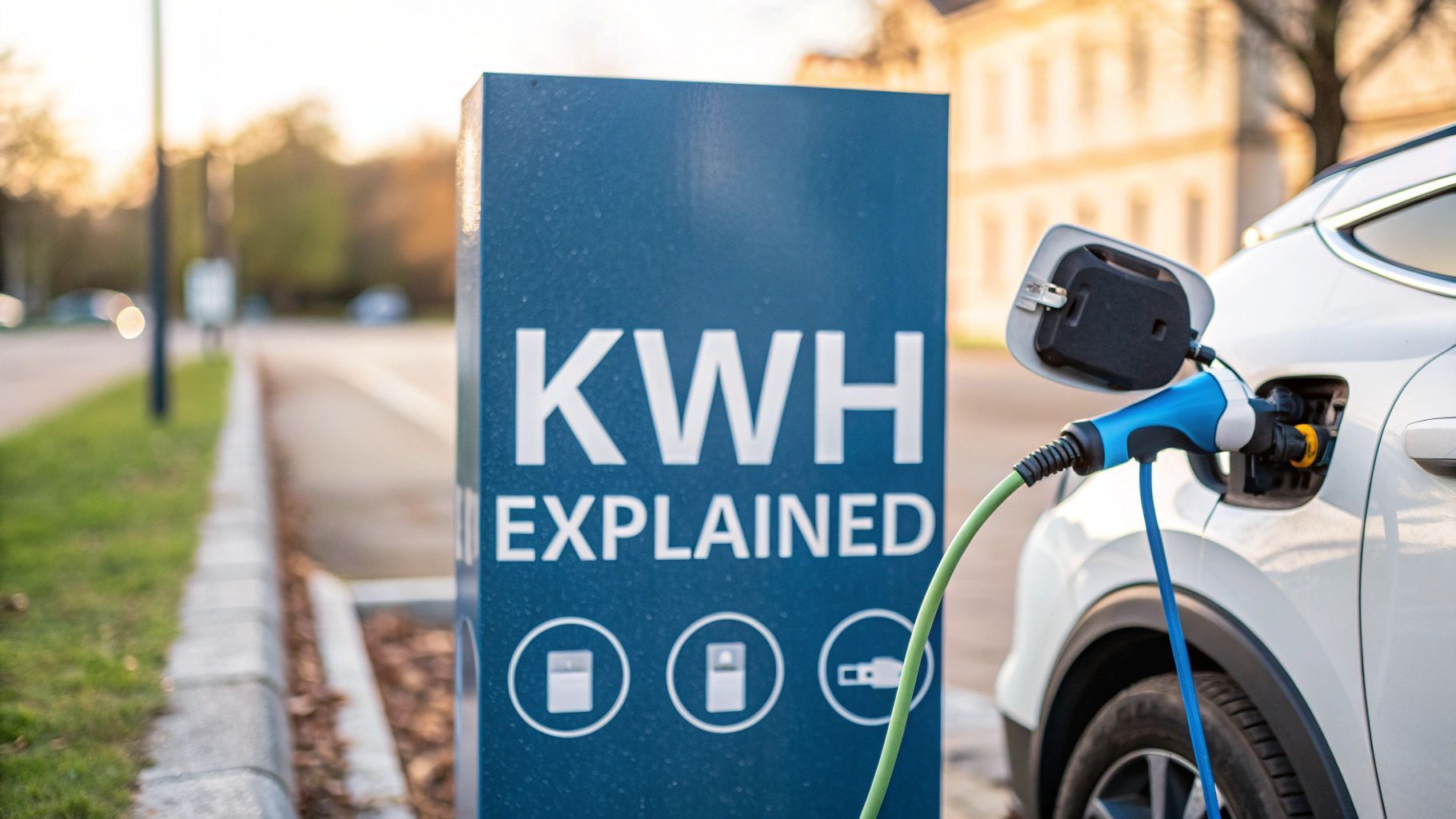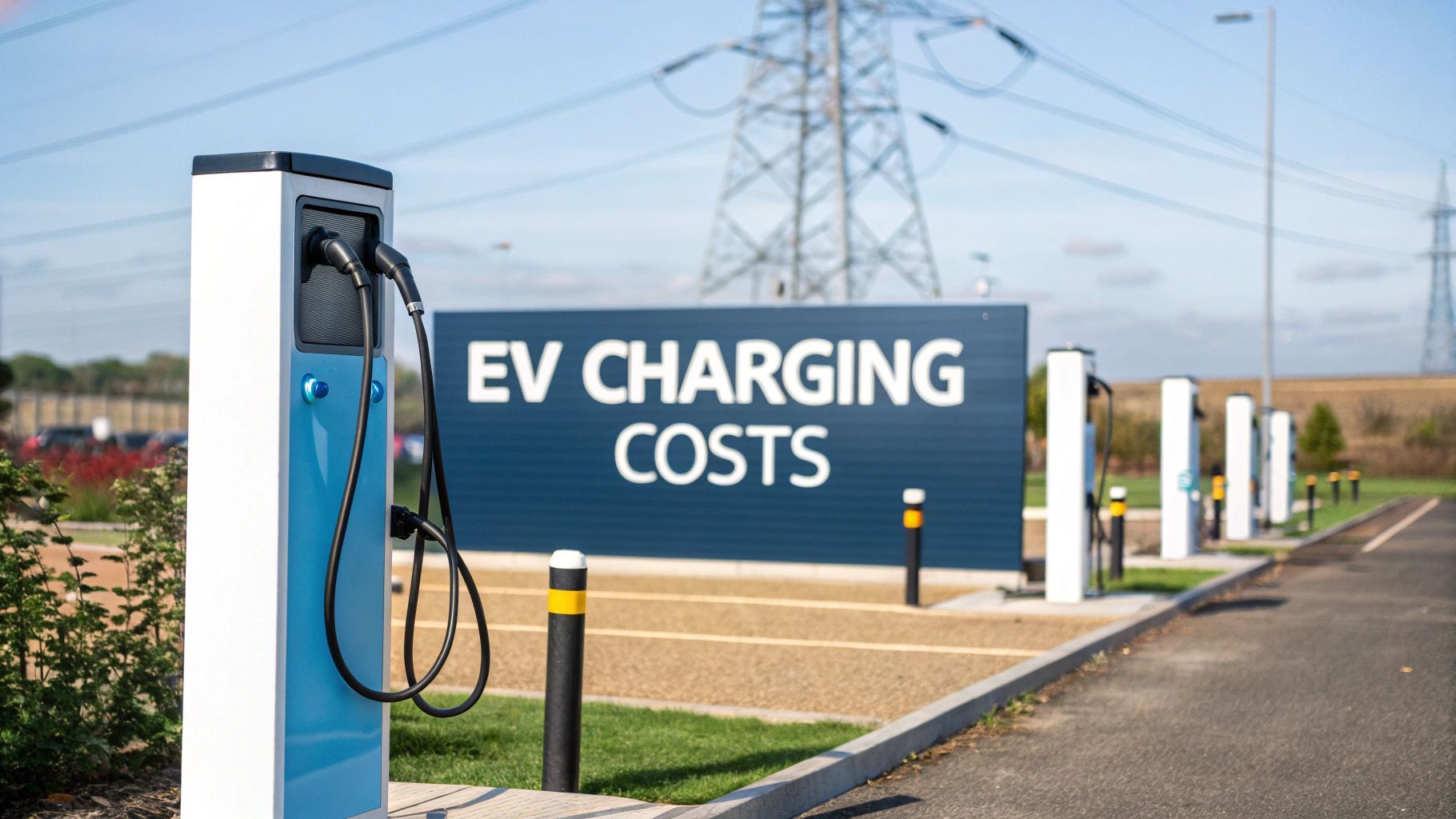Fleet EV Charging: A Practical Guide for UK Businesses
A successful fleet EV charging setup starts with a hard look at your operational reality, not just a quick vehicle count. Before you even think about investing in hardware, you have to get to grips with your fleet's unique energy demands and daily rhythms. This is how you build a cost-effective and efficient charging strategy .
Getting this foundational analysis right is what stops you from making expensive mistakes, like splashing out on rapid chargers you don't need or, even worse, under-provisioning and leaving your vehicles without enough power.
Auditing Your Fleet's Real-World Charging Needs
Jumping straight into choosing chargers is one of the most common—and costly—mistakes I see. A smart transition to electric vehicles is built on solid data, not guesswork. By carefully analysing how your fleet operates right now, you can build a detailed charging profile that perfectly matches its daily rhythm. The goal is simple: make sure vehicles are always ready to go without wasting a penny on oversized infrastructure.
This whole process is about looking beyond just the number of vehicles to understand how , when and where they actually use energy. Honestly, it’s the most important step in designing a fleet charging system that will still be working for you years down the line.
Analyse Vehicle Mileage and Route Patterns
First things first, you need to gather detailed data on how your vehicles move. Just knowing the total daily mileage isn’t nearly enough; the devil is in the detail of your routes.
Are your vehicles doing short, predictable urban delivery runs or are they tackling long-distance journeys with unpredictable stops? This is where your telematics data becomes invaluable. It gives you a granular view of average and maximum daily distances for each type of vehicle, which directly tells you what kind of battery capacity and daily energy top-up you'll need.
A fleet of last-mile delivery vans covering 50 miles a day has completely different energy needs from a sales team driving 200 miles across the country. Understanding these patterns is key to figuring out if slow overnight charging will cut it or if you'll need faster, opportunistic charging during the day.
This infographic gives you a quick rundown of the core process, from digging into your mileage to figuring out your total energy draw.

To help you get started, this framework breaks down the key questions you should be asking.
Fleet Charging Needs Assessment Framework
| Operational Factor | Key Question to Ask | Implication for Charging Strategy |
|---|---|---|
| Vehicle Routes | Are routes predictable and under 100 miles, or long-distance and variable? | Shorter, predictable routes are ideal for centralised overnight AC charging. Longer routes may need DC rapid chargers at depots or public charging access. |
| Dwell Time | How long are vehicles stationary and where (e.g., 8+ hours at depot, 45-min lunch breaks)? | Long dwell times suit cheaper, slower AC chargers. Short breaks demand faster DC charging to be effective. |
| Shift Patterns | Do vehicles operate 24/7 or return to base at the end of a single shift? | Single-shift operations are perfect for overnight charging. Multi-shift vehicles need rapid charging between shifts to maintain uptime. |
| Payload Weight | Do vehicles run empty or are they consistently carrying heavy loads? | Heavier loads significantly reduce vehicle efficiency (miles/kWh), increasing the daily kWh needed per vehicle. |
| Seasonal Variation | Does your operational tempo change throughout the year (e.g., peak delivery season)? | Your infrastructure must be sized for peak demand, not just the average day, to avoid bottlenecks. |
| Site Location | Is your depot located in an urban area with a strong grid or a rural one with constraints? | Grid capacity might be the single biggest limiting factor. Early assessment is critical to avoid delays and costly upgrades. |
Thinking through these factors gives you a much clearer picture of what you truly need before spending a single pound.
Evaluate Vehicle Downtime and Dwell Periods
Just as important as when your vehicles are moving is when they’re standing still. You need to identify every period when your vehicles are stationary and could potentially be charging. This "dwell time" is your golden opportunity.
-
Overnight Depot Parking: If your vehicles return to a central depot and park for eight hours or more, slower AC chargers are almost always the most economical and efficient choice. As a bonus, they're also gentler on battery health in the long run.
-
Mid-Shift Breaks: For vehicles that are on the go around the clock, look for shorter breaks in their schedule. A 45-minute lunch break can be a perfect window for a DC rapid charger to deliver a significant energy boost.
-
Loading and Unloading Times: Don't overlook those 20-30 minute periods at distribution centres. With the right infrastructure, even these short stops can be used for a quick top-up charge.
By mapping out these dwell periods, you can align your charging infrastructure with your natural operational workflow. This minimises disruption and ensures that charging happens when vehicles are already idle, maximising productivity.
Calculate Total Energy and Power Demand
Right, with your mileage and downtime data in hand, you can finally calculate your fleet's core energy requirements. It’s a two-part calculation that will define the scale of the infrastructure you need.
First, work out the total daily energy demand in kilowatt-hours (kWh). For instance, if you have 20 vans that each travel 60 miles a day with an efficiency of 2.5 miles per kWh , the maths looks like this:
(20 vans × 60 miles) ÷ 2.5 miles/kWh = 480 kWh per day.
Second, you need to determine your peak power demand in kilowatts (kW). This is the absolute maximum amount of power you'll pull from the grid at any one time. If all 20 of those vans start charging simultaneously on 7kW AC chargers, your peak demand would be 20 × 7kW = 140 kW .
This number is absolutely crucial. It's the figure that tells you whether your site's current grid connection can even handle the load. This audit gives you the essential data to start having serious conversations about grid capacity and whether you need to explore options like on-site renewables or battery storage.
Working With Grid Constraints And Power Upgrades

That peak power demand figure you calculated? It’s more than just a number on a spreadsheet. It’s the single data point that will shape your entire infrastructure strategy. From my experience, the local electricity grid connection is the biggest bottleneck most fleet depots face. Why? Because most commercial sites were simply never built to handle a large-scale fleet EV charging operation.
Pushing your connection past its limit will, at best, trip the breakers and halt operations. At worst, it can cause prolonged and costly downtime. Understanding your site's electrical limits isn't just a box-ticking exercise; it's the foundation of the entire project. You absolutely have to know what you’re working with before a single charger is installed.
Engaging With Your Distribution Network Operator
The first call you need to make is to your local Distribution Network Operator (DNO). These are the companies that own and operate the poles and wires delivering power to your property and they hold the keys to your project's feasibility. Specifically, they can tell you your site’s Maximum Import Capacity (MIC) —the absolute ceiling for the power you can draw from the grid.
Get in touch with them as early as possible. You'll need to submit an application detailing your plans, including how many chargers you want and their power ratings. The DNO will then assess whether your current connection can cope or if an upgrade is on the cards. Be prepared for this to take time—often several months—as it can involve site surveys and detailed planning.
A full grid upgrade can be an eye-wateringly expensive and lengthy ordeal, sometimes running into hundreds of thousands of pounds and taking over a year to complete. This is exactly why you need to exhaust every option for working within your existing constraints first. Making the most of the power you already have is always the smartest, most cost-effective move.
Charging From a Constrained Grid Connection
Just because your grid connection is limited doesn't mean your electrification plans are dead in the water. This is where intelligent technology comes in, offering powerful ways to manage your energy consumption and charge a whole fleet on a seemingly constrained supply.
The most effective tool in your arsenal is smart charging software, often part of a wider Energy Management System (EMS). Think of it as the brain of your charging depot, intelligently managing how and when vehicles are charged to ensure you never breach your site’s power limit.
By cleverly staggering charging sessions and dynamically adjusting power delivery based on real-time site demand, you can support a surprisingly large number of chargers on a limited grid connection. This avoids costly upgrades and makes the most of the infrastructure you already possess.
This approach transforms your depot from a passive power drain into a managed energy ecosystem. You can dig deeper into this by exploring advanced grid energy management strategies.
Deploying On-Site Energy Solutions
If you're facing serious grid limitations, you can take matters into your own hands by generating and storing your own power right at your depot. This is where distributed energy resources become a genuine game-changer for fleet operations.
Here are a few of the most impactful options:
-
Grid-Scale Batteries: A Battery Energy Storage System (BESS) is arguably the most powerful solution. You can trickle-charge the battery during off-peak hours when grid demand (and electricity prices) are low. It then discharges that stored energy to power your EV chargers during peak times, effectively boosting your grid connection and slashing your running costs.
-
On-Site Renewables: Pair a BESS with solar panels on your depot's roof and you’ve essentially created a self-sufficient microgrid. The solar can charge the battery during the day and you can then use that clean, free energy to charge your fleet overnight. This drastically reduces your reliance on the grid and your carbon footprint.
-
Mobile EV Charging: For more immediate or temporary needs, mobile EV charging units offer incredible flexibility. These are essentially large batteries on wheels that can be brought to your site for rapid charging without any permanent grid connection. They are a perfect stop-gap while you're waiting for infrastructure upgrades to be completed.
Choosing the Right Charging Hardware for Your Operations
Once you've got a solid grip on your fleet’s energy demands and your site’s grid limitations, it’s time to pick the right charging hardware. This decision goes way beyond just grabbing the fastest charger on the market; it's about matching the technology to the real-world rhythm of your operations to build an efficient, reliable fleet EV charging ecosystem. The market is packed with options and getting this choice right means investing in a solution that works today and grows with you tomorrow.
From slow overnight units to powerhouse rapid chargers, each type has a specific job to do. The trick is to see them not as competing options but as different tools for different tasks.
Distinguishing AC from DC Rapid Charging
At its core, the choice in charging hardware comes down to AC (Alternating Current) versus DC (Direct Current). Understanding the difference is crucial because they serve completely different operational needs and come with wildly different price tags and installation hassles.
AC chargers are the steady workhorses, delivering power between 7kW and 22kW . They are perfect for situations with long dwell times, like depots where vehicles are parked up overnight for eight hours or more. They’re cheaper to buy and install and they’re also a bit gentler on a vehicle’s battery in the long run. For a last-mile delivery fleet with a predictable return-to-depot schedule, AC chargers are almost always the most sensible and cost-effective choice.
DC rapid chargers, on the other hand, are all about speed. They deliver power from 50kW all the way up to ultra-rapid units pushing past 300kW . These are built to get vehicles back on the road fast, capable of adding hundreds of miles of range in under an hour. They are absolutely essential for fleets that can't afford long stints of downtime—think long-haul logistics or 24/7 taxi services needing a quick turnaround between shifts.
Choosing the right mix is vital. Over-investing in DC chargers for a fleet that parks overnight is a waste of capital, while relying solely on AC chargers for high-utilisation vehicles will cripple your operations.
For any fleet operator, figuring out the practicalities of setting all this up is a huge part of the puzzle. There's an excellent resource that walks through the whole process in a comprehensive guide to commercial EV charging station installation.
To make the decision clearer, here’s a straightforward comparison of how AC and DC charging stack up for fleet use.
AC vs DC Rapid Charging for Fleets
| Feature | AC Charging (e.g. 22kW) | DC Rapid Charging (50kW+) |
|---|---|---|
| Best For | Overnight charging, long dwell times | Quick turnarounds, en-route top-ups |
| Charging Speed | Slow (4-12 hours for a full charge) | Fast (20-60 minutes for 80% charge) |
| Cost | Lower hardware & installation costs | Significantly higher capital investment |
| Grid Impact | Minimal strain on local grid | High demand, may require site upgrades |
| Battery Health | Gentler, promoting longevity | Can cause more battery degradation over time |
| Ideal Fleet | Last-mile delivery, return-to-depot fleets | Taxis, long-haul logistics, high-use vehicles |
Ultimately, most large fleets end up with a blended approach, using cost-effective AC chargers for the bulk of overnight charging and a few DC units for those urgent, unexpected top-ups.
Exploring Flexible and Mobile Charging Options
Fixed chargers aren't your only play. For businesses needing more flexibility or those facing temporary infrastructure headaches, mobile EV charging units are a brilliant alternative. Think of them as large, transportable batteries that can deliver rapid DC charging wherever you need it, without being tethered to a permanent grid connection.
This makes them perfect for a few key scenarios:
- Temporary Depots: Providing power at new sites before permanent infrastructure goes live.
- Remote Operations: Supporting vehicles working in areas completely off the charging grid.
- Emergency Backup: Acting as a crucial resilience measure if your main depot chargers ever go down.
The growing public charging network also provides a great backup for fleets out on the road. The UK’s public infrastructure has exploded, which has been a huge help for fleet electrification. As of early this year, the UK had 80,998 public charging devices across 39,773 locations, offering a total of 115,241 connectors. That's a massive 30% jump in charging points in just the last year.
Crucially for fleets needing a quick boost, the number of rapid and ultra-rapid chargers (50kW+) has also surged, with 16,259 now available. These powerful chargers make up about 60% of the UK's public charging capacity, a vital lifeline for fleets that can't afford to wait around.
Considering Durability and Software Integration
Finally, remember that the physical charger is only one piece of the puzzle. Commercial-grade hardware needs to be tough enough to survive the daily grind of a busy depot. You should be looking for chargers with a robust build quality, weather resistance and a solid warranty backed by a support team that actually picks up the phone.
Just as important is the software that runs everything behind the scenes. Your chargers must integrate seamlessly with your Energy Management System (EMS). This connection is what unlocks smart charging, load balancing and remote diagnostics, turning a simple piece of hardware into an intelligent asset in your overall energy strategy.
Integrating On-Site Renewables and Battery Storage

To really future-proof your depot and get a grip on volatile energy costs, you have to look beyond simply plugging in chargers. Integrating on-site energy solutions transforms your depot from a passive electricity user into a dynamic, self-sufficient energy hub. It’s all about building resilience and creating a long-term economic edge for your fleet EV charging operations.
When you combine your chargers with on-site renewables like solar panels and couple them with grid scale batteries , you create a powerful synergy. This setup doesn't just reduce your reliance on an often-strained grid; it unlocks serious financial and operational benefits that standalone chargers can't touch.
Using Battery Storage for Peak Shaving
One of the most immediate wins from this approach is tackling peak demand charges. These are the steep tariffs electricity suppliers slap on during hours of high grid demand—which, wouldn't you know it, often line up perfectly with when your fleet needs to charge. This is where a Battery Energy Storage System (BESS) becomes invaluable.
A BESS lets you perform a clever strategy known as 'peak shaving'. The system intelligently charges its batteries during off-peak hours overnight, when electricity is at its cheapest. Then, during the expensive peak periods, it discharges that stored, low-cost energy to power your EV chargers. You're effectively shielding your budget from the highest tariffs.
This simple act of time-shifting your energy use can slash your electricity bills. For a large fleet, the savings from dodging peak demand charges alone can run into tens of thousands of pounds every year, often delivering a surprisingly fast return on the initial BESS investment. For a deeper look, you can learn more about how commercial solar and battery storage can power your business and EV fleet.
By banking cheap energy and deploying it strategically, a BESS effectively flattens your energy demand profile. This not only cuts costs but also eases the strain on the local grid, making you a much better neighbour to your Distribution Network Operator.
Creating an Energy Microgrid with Renewables
Things get even more interesting when you pair your BESS with on-site renewables, like solar photovoltaic (PV) panels on your depot roof. This combination allows you to generate, store and use your own clean energy, effectively creating a resilient microgrid right on your site.
During the day, your solar panels are hard at work generating electricity. Any power not immediately used by the depot or chargers gets stored in your grid-scale batteries for later. This means you can charge your fleet overnight using the free, clean energy you captured from the sun hours earlier.
This setup offers some massive advantages:
- Cost Reduction: You're generating your own free electricity, which dramatically cuts down on how much you need to buy from the grid.
- Carbon Footprint: Powering your EVs with solar makes your fleet operations truly zero-emission from well to wheel, which does wonders for your sustainability credentials.
- Energy Resilience: If a grid outage hits, your depot can carry on. The BESS, kept topped up by solar, can keep your chargers running and your vehicles on the road, ensuring business continuity when your competitors might be at a standstill.
Turning Your Depot into a Distributed Energy Resource
The final step in this evolution is to transform your depot into a Distributed Energy Resource (DER) . Armed with a sophisticated BESS and an intelligent energy management system, you're no longer just an energy user—you become an active player in the energy market.
Suddenly, a major cost centre—your depot's energy consumption—can be flipped into a potential revenue stream. Your BESS can be configured to provide services back to the grid, helping to balance supply and demand. You could, for example, participate in frequency response schemes, where you get paid to rapidly inject or absorb power to keep the grid stable.
By becoming a DER, you unlock entirely new financial models for your fleet. The revenue generated from providing these grid services can help offset the initial cost of the battery system and charging infrastructure. It builds a powerful business case for a fully integrated energy solution and represents the future of smart fleet electrification.
Leveraging Smart Energy Management Software

Installing the chargers is just the start. The real magic in a serious fleet EV charging operation happens behind the scenes, thanks to the intelligent software running the show. Think of an Energy Management System (EMS) as the brain of your depot. It turns what could be a chaotic, expensive power drain into a finely tuned, cost-optimised asset.
Without an EMS, you're essentially just plugging in vehicles and hoping for the best. With one, you're orchestrating a sophisticated energy ecosystem. This software does far more than just basic scheduling; it gives you the crucial intelligence to automate charging based on what really matters to your bottom line: fluctuating electricity tariffs, real-time vehicle battery levels and the total power draw across your entire site.
Automating for the Lowest Cost
The primary job of any quality EMS is to slash your energy bills. The platform keeps a constant eye on wholesale electricity prices, which can shift every half-hour here in the UK. It then automatically gets vehicles charging when energy is cheapest—usually during overnight off-peak hours—all without anyone needing to lift a finger.
For instance, the system knows exactly which vans need to be ready for an early morning shift and makes sure they’re fully charged using the lowest-cost electricity available overnight. This completely prevents accidental charging during peak price periods, delivering massive savings over time. It transforms energy from a fixed overhead into a managed, variable cost you can actually control. You can explore more on the power of smart energy management with ZPN.
Dynamic Load Balancing to Prevent Overloads
One of the biggest headaches for a large-scale depot is accidentally overloading your site's grid connection. An EMS prevents this nightmare through a process called dynamic load balancing . It constantly monitors the total power being pulled by your chargers and everything else on site.
If the total demand ever gets close to your site’s Maximum Import Capacity (MIC), the system intelligently and automatically throttles back the power going to certain chargers. It can prioritise vehicles that need to leave soonest while slowing the charge for those with longer to wait.
This intelligent power distribution is absolutely essential for charging from a constrained grid connection. It lets you run far more chargers than your connection might otherwise support, helping you avoid costly grid upgrades while keeping everything online.
Gaining Actionable Insights from Data
Beyond the automation, a great EMS is an incredible data-gathering tool. It provides granular insights into every corner of your charging operation, which is invaluable for continuous improvement and smarter decision-making.
The software generates detailed reports on:
- Energy Consumption Per Vehicle: Pinpoint exactly how much electricity each vehicle is using, helping you spot inefficiencies or address driver behaviour.
- Charging Costs Per Mile: Calculate the precise operational cost for every vehicle in your fleet, feeding accurate data into your total cost of ownership (TCO) models.
- Hardware Performance: Keep tabs on the health and uptime of individual chargers, flagging potential maintenance issues before they cause real problems.
This constant stream of data allows you to refine your strategy, prove your return on investment and confidently plan for future growth. It also helps manage increasingly capable vehicles. Recent data shows the average electric vehicle range in the UK has climbed to nearly 300 miles per charge, making EVs more practical than ever for a wider range of fleet duties. This extended range, backed by smart charging, helps operators plan routes more effectively and minimise stops. You can read more on EV range advancements from Gridserve.
Common Questions About Fleet EV Charging
Even with a solid plan in place, making the switch to an electric fleet always brings up new questions. Getting clear answers is the key to building confidence and making sure the transition goes off without a hitch.
Let's dive into some of the most common queries we hear from fleet managers about the nuts and bolts of fleet EV charging . The answers usually circle back to a single theme: you need a complete approach where your hardware, software and on-site energy systems all work in harmony. Nail these details and you'll have a smooth, cost-effective operation instead of a constant headache.
What Happens If We Have a Power Cut at Our Depot?
This is one of the first things people ask and for good reason—it’s a major concern for keeping your operations running. The most robust solution is to integrate a Battery Energy Storage System (BESS) directly into your charging setup.
A BESS acts as your own personal power reserve. When the grid goes down, it kicks in, allowing you to keep charging your vehicles so your business doesn't grind to a halt. Without one, a power cut means your chargers are dead in the water, which could be catastrophic for your daily schedule. This is why thinking about energy resilience from day one is so important.
How Much Does a Full Fleet Charging Solution Actually Cost?
This is the big "how long is a piece of string?" question. The final figure can vary wildly depending on the scale of your fleet, the type of chargers you need and whether your site requires significant grid upgrades.
A simple overnight AC charging setup for a handful of vans might only set you back tens of thousands of pounds. On the other hand, a large depot needing multiple DC rapid EV charging units, a major grid connection upgrade and a BESS could easily run into the hundreds of thousands or even millions.
The only way to get a real number is with a detailed site survey and needs analysis. Don't forget to factor in ongoing costs too, like software subscriptions and maintenance plans.
The initial investment can look steep, but you have to weigh it against the huge long-term savings on fuel and maintenance. Plus, government incentives and the potential to earn revenue from grid services can take a serious chunk out of that upfront cost.
For larger operations, programmes like California's EnergIIZE Fast Track 2025 program show just how much support is available for electrifying medium- and heavy-duty vehicles.
Can We Mix Different Chargers and Software?
Technically, yes, but it’s an area where you need to be careful. Most modern chargers are built on open standards like the Open Charge Point Protocol (OCPP), which allows them to talk to different software platforms. This gives you a lot of flexibility.
However, for the smoothest possible operation, it often makes sense to stick with chargers and software that are proven to work well together. Sourcing your hardware and software from a single, unified provider can make life much easier. It simplifies installation, day-to-day management and troubleshooting because you know everything is designed to communicate perfectly.
Do We Need Rapid Chargers If Our Vehicles Park Overnight?
Not always. If your vehicles run on a predictable schedule and are parked up for 8-10 hours every night, then slower, more affordable AC chargers are usually more than enough. This type of charging is also gentler on the vehicle's battery over the long term.
DC rapid chargers really come into their own for fleets that need quick turnarounds during the day. Think couriers, taxis or heavy goods vehicles that can't afford to be off the road for hours at a time. For those top-up charges, the expanding public network is also becoming a fantastic resource.
The UK’s public charging infrastructure is growing at an incredible pace. Recent figures show there are now 86,021 public charging points across 43,507 locations nationwide. This growth is a huge boost for commercial fleets, offering backup when needed. Crucially, the number of rapid charging hubs—sites with six or more high-speed chargers—has topped 650 in the UK, making longer journeys far more practical.
Ready to build a resilient and cost-effective charging solution for your fleet? ZPN Energy delivers fully integrated rapid charging, battery storage, and smart energy management systems designed for the demands of modern business. Explore our solutions at https://www.zpnenergy.com.








